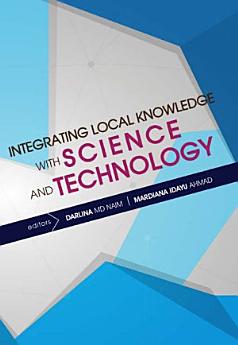Integrating Local Knowledge with Science and Technology (Penerbit USM)
Darlina Md Maim · Mardiana Idayu Ahmad
Jan 2017 · Penerbit USM
Ebook
77
Pages
reportRatings and reviews aren’t verified Learn More
About this ebook
"This book consists of selected articles which is deal primarily with local knowledge in relation to science and technology. The articles are contributed by active researchers, academics and experts from various disciplines with different academic fields. Pieces of work are arranged in didactic writing style with the aim to provide a guide and insight to a public beyond those who are experts in the topic dealt. Two parts constitute this book, the first part - Local Knowledge and Natural Resources (2 articles) and the second, Understanding the Traditional Built Environment (4 articles). The book begins with an article entitled 'Traditional Methods of Extending Dairy Products Shelf Life by Milkmaid in Nigeria' authored by Aminu Nasíru, Mahamad Hakimi Ibrahim and Norizan Esa. This article presents a study on the methods used by Fulani milkmaids in extending the shelf life of dairy products. The methods employed by the Fulani milkmaids for milk processing and preservation stem from indigenous knowledge and has been proven effective as these have been practiced over centuries. The authors conclude and recommend the importance of incorporating the traditional methods of milk processing and preservation with modern scientific methods in preserving and conserving the indigenous knowledge. In the next article, Nur Aqidah A. Aziz, Mardiana Idayu Ahmad, Darlina Md. Naim and Mahamad Hakimi Ibrahim in the article 'Toxic Heavy Metals Contents (As, Pb, Hg, Cd) in Edible and Herbal Plants' discuss the source of heavy metals (natural and anthropogenic source), uptake mechanisms, factor effecting nutrients uptake, significant and health effect on heavy metals, and also standard and guideline related to heavy metals in edible and herbal plants. The second part with an article entitled 'Determination of Location Suitability for Malay Traditional House in Malaysia' authored by Ruhizal Roosli, Noor Faisal Abas, Abu Hassan Abu Bakar, Mazran Ismail and Shardy Abdullah. This article discusses the consideration of determining site selection of Malay traditional house in Malaysia. The discussion is based on several factors such as religious beliefs, climate, topography, economic, historical background, way of life (type of job) and beliefs which will affect the residents in determining the orientation, the exterior (facade) and the placement location. In article four, Noor Faisal Abas, Abu Hassan Abu Bakar, Ruhizal Roosli and Mazran Ismail present an overview of research in 'Use of Materials and Structures in the Construction of Malay Traditional House in the Northern and East Coast of Peninsular Malaysia'. In this article, materials used in the construction of traditional Malay houses in the north and east coast of Peninsular Malaysia for the purpose of conservation and maintaining the design originality were identified. Mazran Ismail, Abu Hassan Abu Bakar, Noor Faisal Abas and Ruhizal Roosli through the article five titled 'Design and Function of the Non- Structural Elements of the Malay Traditional Houses in the Northern and East Coast of Peninsular Malaysia' discuss results of a comparative study of the non-structural elements of the traditional Malay houses in Perlis, Kedah, Penang, Terengganu and Kelantan, in relation to design, symbol and functional aspects. In the last article, Nor Amalin Keling, Abdul Malek Abdul Rahman, Mardiana Idayu Ahmad through their article titled "Thermal Comfort Design Consideration in Typical Malay Traditional House and Traditional Shop House' discuss several factors in designing traditional house and traditional shop house. These factors include building orientation, interior layout space, natural ventilation, natural lighting and stack effect. Nowadays, there has been a shift in the relationship between science, technology and local knowledge in many fields. This book thus provides an overview on how local knowledge has been practised by societies which becomes a significant aspect of their culture and technology that derived from local environment. It is hope that this publication would promote awareness and foster appreciation of local knowledge for the development of local community and individuals through its integration with science and technology."--Pages ix-x.
Rate this ebook
Tell us what you think.
Reading information
Smartphones and tablets
Install the Google Play Books app for Android and iPad/iPhone. It syncs automatically with your account and allows you to read online or offline wherever you are.
Laptops and computers
You can listen to audiobooks purchased on Google Play using your computer's web browser.
eReaders and other devices
To read on e-ink devices like Kobo eReaders, you'll need to download a file and transfer it to your device. Follow the detailed Help Center instructions to transfer the files to supported eReaders.




